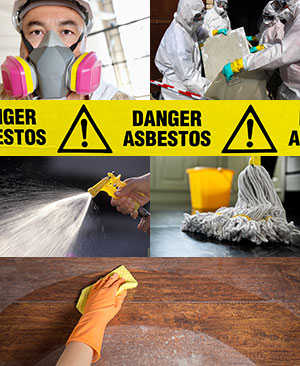Asbestos Exposure and Reducing Exposure
Asbestos exposure

People may be exposed to asbestos by breathing tiny asbestos fibers in the air. The asbestos gets into the air from from natural deposits of asbestos in the earth or from past or current commercial products that contain the minerals. Asbestos fibers usually get into the air when something disturbs them in soil, rock, or older products, such as
- Weathering or erosion of natural deposits of asbestos at the ground surface or old asbestos-containing products
- Crushing rock with natural deposits of asbestos
- Handling, cutting, or crushing old asbestos-containing products, for example, during building renovation or demolition projects
- Disturbing soil contaminated by natural surface deposits or old asbestos-containing products during recreational or other outdoor activities.
- Handling or disturbing consumer products contaminated with asbestos (such as vermiculite or talc)
- Gardening in soil contaminated by asbestos from natural deposits or commercial products
- Cleaning or other household activities that might stir up dust containing asbestos from natural deposits or products
The amount of asbestos that gets into the air people breathe depends on many factors, including
- the location,
- the type of material or soil the asbestos is in,
- the age and characteristics of that material,
- weather conditions and moisture, and
- the intensity of the activity disturbing the asbestos
Once the asbestos fibers get into the air, they will act the same no matter where they came from. A fiber of chrysotile will cause the same risk of disease whether it came directly from a natural deposit or from a commercial product.
People may also be exposed to asbestos by accidentally swallowing fibers or getting them on their skin. However, these types of contact only cause health effects after large amounts of exposure. Also, the effects of swallowing or touching asbestos are less serious than the health effects of breathing asbestos. ATSDR focuses mainly on breathing (or inhalation) exposures when we evaluate possible health effects of exposure to asbestos.
Reducing asbestos exposure
People who work around asbestos, or materials that contain it, should
- Get proper training for handling asbestos
- Wear the right personal protective equipment
People who live in older homes should
- Avoid disturbing materials that might contain asbestos, including
- pipe and furnace insulation, siding, flooring, and popcorn ceilings installed from the 1950s to the 1970s
- vermiculite attic insulation
- Talk to their local or state environmental agency or a certified asbestos contractor if the materials are breaking down or need to be replaced
- Hire contractors who know and follow laws for safe asbestos removal and disposal to avoid contaminating the rest of the home or the environment
People who live in areas with natural asbestos deposits or near areas contaminated by old asbestos-containing products should
- Keep asbestos levels low in the home by
- Using wet cleaning methods and high efficiency particulate air (HEPA) vacuums
- Using doormats and removing shoes before entering
- Keeping windows closed on windy days to keep asbestos out
- Avoid breathing dust outside by
- Using water to wet soil before gardening or playing
- Spraying off patios with water instead of sweeping them
- Staying on pavement or ground covered with grass or mulch
For more information, please see ATSDR’s fact sheet on limiting environmental exposure to asbestos in the “Additional Resources” section of this web site.